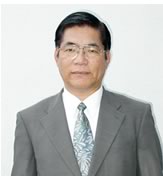
- East Building, Kagawa Prefectural Capital

- Shuzen Takeuchi, Collection of Cut-paper and
Woodblock Prints:
Shikoku Mandala—Aji, 1981,
Sunrise at Mount Goken from Oji Shrine
It was roughly fifty years ago, in the late 1950s, when Japan was experiencing its greatest period of growth. With mass-production and mass-consumerism, the focus at the time was on quantity, not quality. Kagawa Prefecture too seemed to be about to be overwhelmed by that wave of growth. Then governor, Masanori Kaneko, believed that the people of the prefecture needed to see not only economic growth but also cultural developments that would lead to economically and spiritually richer lives. That was the foundation for the concept of today’s Gempei Art Village, and the basis for the Setouchi International Art Festival as well.

Why did Kaneko have such an appreciation for the arts, and why did he make the decisions that charted the route for Kagawa Prefecture’s future? Some say that he was profoundly influenced by someone he attended Marugame Middle School (now Marugame High School) with: Genichiro Inokuma. Inokuma is known as a Japanese painter in the Western style. Perhaps it was Kaneko’s friendship with Inokuma that led him to realize that a rich appreciation of the arts could lead to the revitalization of local communities. When it came time, for example, to re-design the prefectural capital buildings, Inokuma lent an ear, and is said to have introduced Kaneko to the father of modern Japanese architecture, Kenzo Tange. Tange’s design of the East Building of the Prefectural Capital would then later be selected as one of Japan’s top 100 public works projects. Furthermore, Inokuma drew on his broad connections when, in 1957, UNESCO made a request for a stone sculpture and he came to Shikoku and together with Kaneko sought out the sculptor Isamu Noguchi.。
Then, in 1959 at the introduction of Tange, the sculptor Masayuki Nagare came to Kagawa. After being greatly welcomed by Kaneko, Nagare began sculpting in Aji, and even moved his base of operations to this area. After that, the community of artists grew even further when, in 1964, at the recommendation of Nagare, George Nakashima visited Sakura Seisakusho in Mure and yet another outstanding artist graced Kagawa.
The friendship between one governor and one artist led to connections between artists of the world and the Gempei area, and the foundation of the Gempei Art Village. However, it was not just a community of people that led artists of the world to love this place. There are also quality materials, including Aji Stone, incredibly skilled and artistic Sanuki craftsmen, the warm climate afforded by the Seto Inland Sea and the unforgettably beautiful scenery of the islands floating there.
We live in a time when the material means less and the spiritual means more. In the Gempei area, where history and art come together, we learn that our hearts are truly rich. In a place so many artists have loved, we find new artists, creating still more, an impetus for the next generation. This is the Gempei Art Village.

![]()

Born in Kagawa Prefecture in 1947, began working at the Prefectural Capital in 1967. Worked at the Prefectural Design Office from 1972 to 1975. Researched and responsible for design strategy specific to local and cultural revitalization under Governor Masanori Kaneko. Involved in multiple planning roles after leaving the Design Office, in the Planning Division and Tourism Section, for events and expositions, as well as tourism policy, Sanuki Seto Regional Revitalization Vision Planning, etc. Retired in 2003 as the head of the Political Strategy Division’s Regional Revitalization Section (for Cultural Revitalization and Seto Inland Sea Revitalization). Became a Regional Revitalization Advisor for Kagawa Prefecture. Guest editorialist for the Shikoku Shimbun. Part-time lecturer, Faculty of Economics, Kagawa University. Instructor in trade training (design). Continues to publish numerous works as a cut-paper and woodblock print artist.



